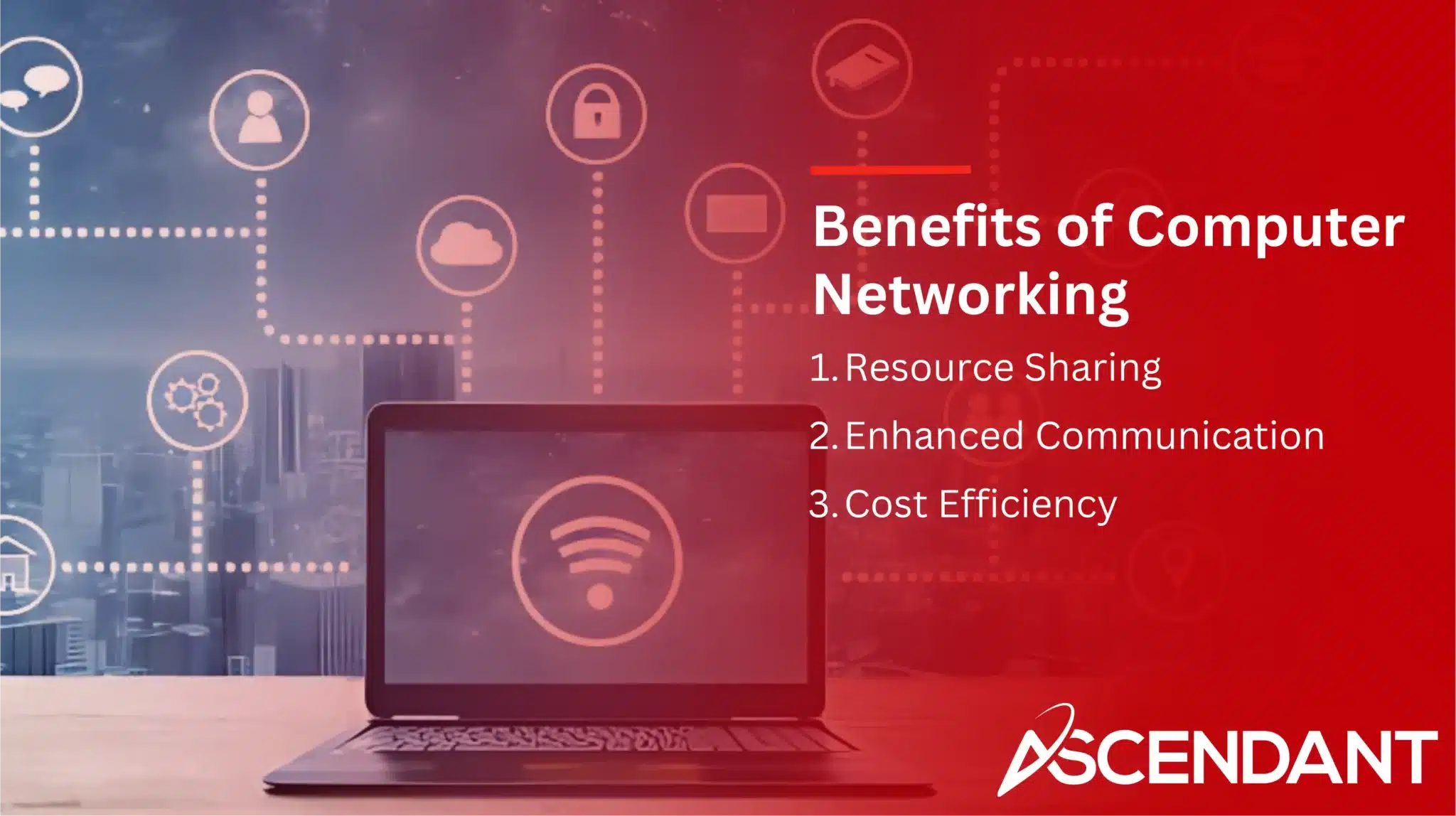A computer network connects multiple devices to share resources and exchange information. Whether at home or in large businesses, networks are essential. This guide explains the basics, key components, and benefits, and dives into network security.
Key Takeaways
- A computer network interconnects devices to facilitate communication and resource sharing, utilizing wired and wireless connections based on requirements.
- Key components of a computer network include nodes, links, devices such as routers and switches, transmission media, and communication protocols that ensure efficient data transfer.
- Computer networks offer significant benefits including resource sharing, enhanced communication, and cost efficiency, while also requiring robust security measures to safeguard against cyber threats.
What is a Computer Network?
A computer network serves as a digital framework that links multiple devices together, allowing them to engage in communication and resource sharing with ease. The scope of such a network connection can be as simple as a local setup within a household or an intricate system spanning diverse locations in large-scale enterprise networks. These networks play an essential role by enabling the flow and exchange of data and resources, thereby proving to be crucial elements in our interconnected society.
In terms of their architecture, modern computer networks may either incorporate wired or wireless technologies depending on specific needs. Wired connections like Ethernet are known for providing superior speed and dependability when it comes to data transmission. Conversely, wireless options such as Wi-Fi afford more flexibility along with convenient access points for users. When designing these systems, considerations about the distance between linked devices take precedence alongside choices regarding connector types used throughout the infrastructure. Depending on how extensive an organization is, its network’s complexity may reflect this scale – affecting how distant devices can effectively maintain connectivity.
At their core function, computer networks act as vital conduits for communications across different settings—ranging from personal home use to expansive multi-national corporations—and include various gadgets like smartphones, servers computers, and printing machines into their webwork greatly amplifying functionality through interconnectivity. By centralizing databases within these structures, they substantially minimize inconsistencies while simultaneously advancing service quality via provisioned communal informational access among personnel.
Key Components of a Computer Network
At the core of computer networking are its essential elements, consisting of nodes and links. Nodes encompass network-connected devices such as computers and printers, whereas links denote the physical or conceptual connections interlinking these nodes. These integral components coalesce to enable communication and data transfer across the network.
Computer networks can be classified based on various factors like their transmission medium, scale, configuration, and purpose. Comprehending these elements is vital for a thorough understanding of how computer networks perform and manage information flow.
We examine network devices alongside transmission media and communication protocols. Each constitutes a significant segment in constructing the overarching structure of network architecture.
 Network Devices
Network Devices
In contemporary computer networks, network devices play a pivotal role in bridging connections among multiple entities. Such devices encompass a range of equipment such as desktops, server machines, routers, switch systems, and specific networking hardware like the network interface card (NIC). Within this ecosystem of connectivity, for instance, wireless device routers orchestrate the distribution and management of data traffic while enabling seamless wireless interactions across units. Meanwhile adapters including Internet modems stand crucial in actualizing access to these networks.
The contribution of these components extends beyond mere connection facilitation. They are integral to establishing foundational parameters within any given network. Devices such as routers and switches along with firewalls and wireless access nodes supply critical metrics necessary for ongoing surveillance and regulation of both efficacy levels and security posture inherent within a system’s performance dynamics.
The skeleton that forms modern computer network architecture is composed heavily from an array of aforementioned hardware pieces which collectively guarantee coherent transference efficiency regarding operational information flow—an essential characteristic that substantially boosts overall systemic functionality—accommodating wired protocols alongside their increasingly prevalent counterpart: untethered digital communications solutions.
Transmission Media
Network devices communicate via channels known as transmission media, which are essential for data transmission. These conduits come in two main forms: wired and wireless. Among the wired options are coaxial cables, Ethernet cables, and fiber optic cables – each providing varying speeds and dependability levels. Notably, fiber optic cables stand out for their ability to facilitate rapid data transfer across extensive networks.
In contrast to their wired counterparts, wireless networks harness technologies like Wi-Fi that utilize radio or electromagnetic waves to send data through the air. This method offers significant advantages regarding installation convenience and adaptability in situations where deploying wires is challenging or impossible.
Whether through wire-lined paths or unseen airborne signals, these varied types of transmission media are indispensable components underpinning the seamless operation of contemporary network infrastructures by enabling prompt and precise delivery of information.
Communication Protocols
The set of rules enabling the exchange of data between networked devices is known as communication protocols. These conventions are vital for allowing interoperable communications amongst diverse hardware and software systems, controlling how information is structured, sent out, and received to facilitate uninterrupted interactions throughout the network.
Among these prevalent communication protocols are:
- TCP/IP, which establishes a framework for contemporary networks across four separate functional strata
- IEEE 802 encompasses a suite of standards pertinent to Local Area Networks (LANs) and Metropolitan Area Networks (MANs), with Wi-Fi (or WLAN under its more technical name) being among its most recognized iterations.
- Ethernet plays an indispensable role in ensuring that networks function fluidly by providing secure and effective transmission of data.
These established protocols guarantee not only efficient but also secure transfer of information within various networking environments.
Communication protocols extend beyond merely setting guidelines for transmitting data. They specify procedures for dispatching and retrieving this information over a given network. The implementation involves utilizing distinct signaling techniques to dictate how packets are conveyed—be it simplex mode where one-way traffic prevails or duplex modes such as half-duplex or full-duplex allowing two-directional exchanges either alternately or simultaneously respectively. Such mechanisms that define both methods & means in managing packet flow remain crucial elements underpinning any computer network’s reliable performance coupled with proficient operational capacity.
How Do Computer Networks Operate?
Computer networks function by adhering to certain communication protocols, which are essential in establishing rules for data exchange among various nodes. These regulations facilitate the identification of devices and their intercommunication, ensuring that information is conveyed accurately and effectively throughout the network. For example, a widely adopted protocol like Internet Protocol (IP) plays a critical role in node identification and interaction within a network.
To comprehend how computer networks work, it’s important to understand concepts related to data transmission as well as various network topologies. Data flow patterns across the network and factors influencing performance stability can be attributed to these fundamental aspects.
In subsequent sections, we will delve into more detail regarding methods of transmitting data along with an examination of distinctive types of network topologies. Their importance cannot be overstated when considering their impact on the functional dynamics of computer networks.
Data Transmission
The fundamental role of computer networks lies in the transfer of data between devices, which is facilitated through diverse physical mediums. The strategy commonly employed to enhance this process includes packet switching, a technique where data is segmented into packets that enable more efficient navigation and delivery across the network. Such an approach significantly improves network performance by judiciously utilizing bandwidth and reducing potential lags during data transmission.
To accommodate different communication needs within these networks, there are several methods for transmitting information such as simplex (unidirectional), half-duplex (bidirectional but not simultaneously), and full-duplex (bi-directional at the same time). By deploying these various modes according to necessity, they provide tailored solutions that support optimal operation for distinct types of applications while also aligning with specific configurations of individual networks.
Network Topologies
Network topologies delineate the arrangement of elements such as links and nodes in a physical or logical manner within a network. The selection of an appropriate topology can significantly influence factors like performance, reliability, and growth potential of the network. Among various types are star, mesh, and ring topologies.
One prevalent type is the star topology where each device is linked to a singular central hub. This setup facilitates easier management but at the same time creates vulnerability due to its reliance on one point that, if failed, could bring down the entire system. Its straightforwardness coupled with easy troubleshooting makes it highly favored for smaller scale networks found typically in homes or small business settings.
Conversely, mesh topology stands out by interconnecting every node to several others, which bolsters both reliability and performance through alternative data pathways.
In contrast, again, is ring topology wherein information traverses circularly around the network resulting in reduced instances of data collisions yet maintaining susceptibility to failures at any single connection point much like star configuration does. Each different layout brings unique benefits along with inherent challenges thus making knowledge about these structures crucial when planning out networks so they meet efficiency needs while being robust against failure points and capable enough for future expansion demands.
Types of Computer Networks
Networks within the realm of computers are distinguishable by various factors, such as their scale, geographic scope, intended use, choice of transmission medium, and the configuration of network connections known as network topology. The array includes several prevalent forms like Personal Area Networks (PAN), Local Area Networks (LAN), Campus Area Networks (CAN), Enterprise Private Networks (EPN), Metropolitan Area Networks (MAN), Wide Area Networks (WAN) and Global Area Networks (GAN). Each possesses distinct traits tailored to fulfill specific functions.
In contemporary networking scenarios, there is a seamless integration of not just conventional computer devices but also ordinary objects like thermostats and cameras into the ecosystem. This reflects on their wide-ranging utility in diverse domains. Essential for handling sophisticated tasks that demand swift data exchange—such as video streaming or hefty file transfers—are robust rates at which data can be transmitted across these network connections.
Subsequent sections will delve into an in-depth examination of some common varieties of networks. Emphasis will be placed on delineating each type’s distinguishing aspects along with potential applications they may cater to within this expansive domain.
Local Area Network (LAN)
A local area network (LAN) serves the purpose of linking multiple devices within a restricted space, such as an office, home, or educational institution. By utilizing Ethernet or Wi-Fi technologies for connection purposes, LANs facilitate swift data exchanges and suit scenarios where numerous devices require interaction and resource sharing.
The scope of a LAN can vary widely from supporting just one user to accommodating thousands of connected devices. It streamlines workflows by enabling centralized file storage solutions that allow individuals to access and modify up-to-date documents collaboratively. Given its straightforwardness and affordability in setup costs, this kind of network is particularly prevalent in small business environments as well as residential settings.
Wide Area Network (WAN)
Wide Area Networks (WANs) function to connect numerous Local Area Networks (LANs) across broad geographical expanses. The construction of a WAN involves the interconnection of several LANs, which often use wireless mediums such as radio towers for communication, enabling messages to be transmitted over great distances. Such networks are vital for entities with various premises, as they facilitate seamless connectivity and interaction.
To bridge the distance between different LANs spread out geographically, WANs typically employ technologies like leased lines or dial-up services. These expansive networks play an indispensable role for corporations and organizations that demand reliable communication channels over long ranges, delivering the essential network infrastructure necessary to sustain their activities.
Metropolitan Area Network (MAN)
Metropolitan Area Networks, or MANs, serve to link networks within a designated broad urban space. They act as intermediaries between local area networks and broader network infrastructures. Covering areas from 5 to 50 kilometers in range, they are adept at connecting various networks throughout an expansive campus or citywide setting. The high-speed connectivity that MANs offer makes them perfectly suited for metropolises where there is a need for multiple networks to interface.
To unite local area networks over the expanses of an entire metropolitan locale, MANs utilize rapid connection technologies such as fiber optic cables. Municipal governments, educational bodies, and small enterprises frequently employ this kind of networking structure due to its capacity for promoting efficient communication and sharing resources across the metropolitan expanse.
Benefits of Computer Networking

Networking in the realm of computers provides a wealth of advantages, including notable improvements in efficiency, strengthened security measures, and promotion of creativity—all while managing to minimize expenses. This form of connectivity enhances cooperation and the exchange of knowledge significantly, propelling innovation among groups and throughout entire organizations. Computer networking is integral to contemporary modes of communication as it allows devices to link up with one another and share resources seamlessly.
The indispensability of computer networking spans multiple settings—from corporate entities to academic institutions—owing much to its vital role in enhancing organizational performance. Subsequent sections will delve into how sharing resources through networks can lead not only to better communication but also cost savings that underscore their value for bolstering operational effectiveness and fostering collaborative endeavors.
Resource Sharing
The ability to share resources is a key advantage of computer networks. These networks allow users to distribute both data and hardware without being constrained by geographic boundaries, making it possible for multiple locations to access the same resources. This breaks down barriers to resource isolation, bolstering collaborative efforts and streamlining work processes.
In environments where computers are connected via a network, shared use of peripherals like printers, storage systems, and software applications becomes feasible. This collective utilization can lead to significant savings on hardware purchases as there’s less need for repetitive assets across the user base while simultaneously decreasing operational expenses. The process of sharing happens in such a way that allows different individuals on separate computers access files or devices effortlessly.
Networking presents an economically savvy option that benefits entities regardless of their scale due solely to its inherent efficiency in deploying available resources effectively.
Enhanced Communication
Computer networks are pivotal in fostering enhanced communication within the modern business landscape. By enabling digital communication mediums like email and instant messaging, they connect a plethora of users, thus facilitating effortless information exchange. This interconnectivity streamlines interactions between employees, suppliers, and clients alike, bolstering organizational efficiency through improved dialogue.
The role of computer networking extends to real-time interaction and effective project management across numerous platforms which underpin teamwork and elevate productivity levels. Through the deployment of networks that support e-commerce activities, video conferencing capabilities as well as seamless emailing and file-sharing processes. Everyday business tasks become more expedient and collaborative efforts among team members along with external stakeholders are significantly advanced.
Serving as an integral framework for communicative endeavours within businesses large or small—computer network work stands at the forefront of innovation in today’s corporate sphere. They maintain continuous connections amongst various operational tiers, ensuring enterprises remain agile amidst ever-evolving market demands—an attribute particularly instrumental within enterprise computer networks where efficacy is paramount.
Cost Efficiency
Computer networks bring about considerable cost savings by cutting down on the necessity for redundant hardware. These savings emerge as a result of sharing resources such as printers and storage solutions, which eliminates the need to buy separate equipment for each user or workstation, particularly aiding small to medium-sized enterprises in better allocating their financial resources.
In essence, creating computer networks bolsters operational efficiency by streamlining resource use and diminishing unnecessary duplication. This aspect of cost-effectiveness is crucial alongside other networking advantages in supporting organizations that strive to enhance their productivity and competitive edge.
Network Security and Defense
Ensuring the integrity of data and protecting computer networks from a multitude of security threats is crucial for network security. Its primary objective is to defend the fundamental networking infrastructure against illicit access and exploitation while preserving confidential information and ensuring the uninterrupted reliability of network services.
In order to maintain solid network protection, effective strategies involve an amalgamation of robust defense tools and best practices that combat cyber risks and assaults. Subsequent sections will delve into these pivotal network defense instruments as well as recommended methods essential in safeguarding organizational resources and data within the realm of network security.
Network Defense Tools
Computer networks deploy a range of defense mechanisms to shield against illicit entry and digital threats. Firewalls play an essential role in this protective effort, serving as the gatekeepers that differentiate between secure internal networks and potentially unsafe external ones. They function alongside routers and switches which manage data flow and fortify security, guaranteeing the integrity and smooth functioning of devices connected to the network.
Safeguarding measures include Intrusion Detection Systems (IDS) along with Intrusion Prevention Systems (IPS). These systems are instrumental in scanning ongoing network traffic for unusual patterns or activities indicative of a threat, thus enabling organizations to promptly address any signs of compromise.
The dynamic landscape of cyber threats necessitates integrating these varied tools into a comprehensive strategy for securing network environments. This multi-pronged approach ensures robust protection from potential intrusions.
Best Practices for Network Security
Ensuring the security of computer networks is imperative to defend against a variety of security threats. To maintain robust defenses, it’s important to consistently update software and systems, which helps in addressing vulnerabilities. Employing strong authentication processes like multi-factor authentication can markedly diminish incidents of unauthorized network access.
Managing who has entry to the network forms a central part of safeguarding it. This process entails accurately recognizing users and devices for the effective application of security policies within an organization’s secure network framework. The practice known as network segmentation divides traffic into distinct sections, greatly facilitating the implementation and management through clear-cut enforcement boundaries via network access control measures.
By committing to these recommended strategies, businesses are better positioned to bolster their defense mechanisms regarding their computer networks—securing critical data and resources from potential cyber risks effectively.
Future Trends in Computer Networking
Emerging trends like automation and virtualization are molding the landscape of computer networks. The expansion of IoT devices coupled with a surge in digital business activities necessitates the development of modern computer networks that can manage elevated levels of data traffic. In response, companies are enhancing their network capabilities by integrating automated operations and employing cutting-edge technologies to boost performance.
To address the requirements posed by contemporary business settings, advanced techniques for managing network traffic, network virtualization, and automation have become indispensable tools. Following this discussion on how automation and virtualization influence management practices within these spheres, we will delve into why sophisticated methods for managing increasing volumes of network traffic are crucial.
Automation and Virtualization
The introduction of automation and virtualization is transforming network management and operations significantly. Through the application of virtualization, distinct secluded environments are established, which permits several virtual networks to function concurrently on a single physical infrastructure, thereby improving scalability and efficiency. The integration of machine learning algorithms into automated network management can augment its capability by enabling adaptability in response to fluctuating conditions and requirements.
Centralized network administration is facilitated by these advancements, simplifying the oversight and reducing expenses associated with maintaining expansive computer networks. Organizations stand to benefit from enhanced network performance and dependability through automating mundane tasks alongside optimizing the distribution of resources. This ensures that their networks are equipped to meet the escalating demands placed upon them in contemporary business contexts.
Increased Network Traffic Management
The escalation of data volumes demands sophisticated traffic management strategies to uphold the integrity and performance of networks. Implementing systems such as software-defined networking (SDN) helps in real-time adaptation of resource distribution, guaranteeing optimal utilization of network resources.
Employment of these cutting-edge traffic management technologies assists companies in managing the surge in data traversing their networks. Through effective regulation of network traffic, entities are able to sustain uninterrupted high-speed internet access and dependable network functionality, which is fundamental for smooth business operations and a consistent user experience.
Summary
In essence, grasping the intricacies of computer networks—including their elements, functionality, and various forms—is essential for maximizing their advantages. Computer networking is a fundamental aspect of contemporary commerce and everyday existence that significantly bolsters communication and resource sharing while boosting cost-effectiveness and security. Looking ahead, developments such as automation and virtualization are poised to redefine the realm of computer networking by fostering progress and proficiency. Harnessing the strength of networking is key to remaining interconnected, protected, and at the forefront in today’s digital era.
 Frequently Asked Questions
Frequently Asked Questions
What is a computer network?
A computer network is a system that connects multiple devices to facilitate communication and resource sharing. This is crucial for the efficient exchange of information in today’s interconnected society.
What are the key components of a computer network?
The key components of a computer network comprise network devices such as routers and switches, transmission media including cables and Wi-Fi, and communication protocols like TCP/IP and IEEE 802.11n.
These elements work together to enable effective data transmission and connectivity.
How do computer networks operate?
Computer networks operate through established communication protocols that facilitate efficient data transmission and interaction among devices. This structured approach ensures seamless connectivity and information exchange.
What are the benefits of computer networking?
The benefits of computer networking include resource sharing, enhanced communication, and cost efficiency, all of which significantly improve productivity and collaboration within an organization.
Ultimately, effective networking leads to optimized operational costs.
What are some future trends in computer networking?
Emerging trends in the field of computer networking will concentrate on implementing automation, virtualization, and sophisticated traffic management strategies to efficiently handle increasing data amounts while boosting network performance.
Adopting these technological advancements is essential for maintaining a competitive edge within the constantly changing digital environment.

